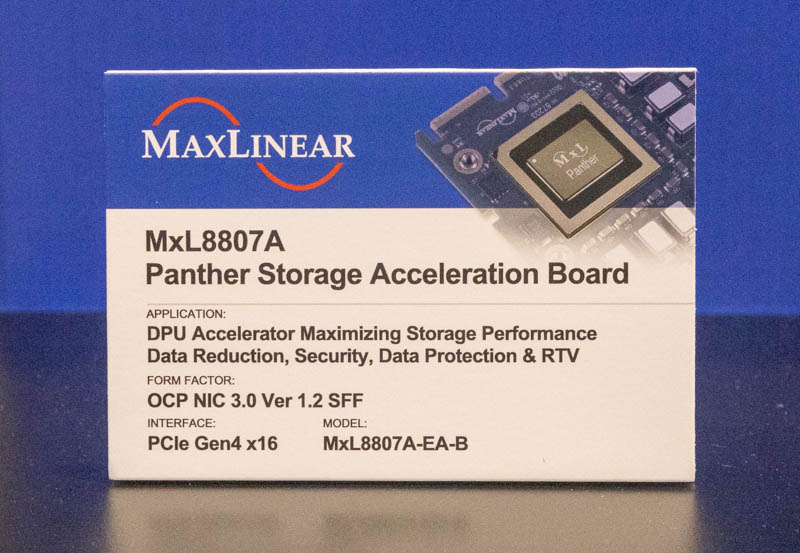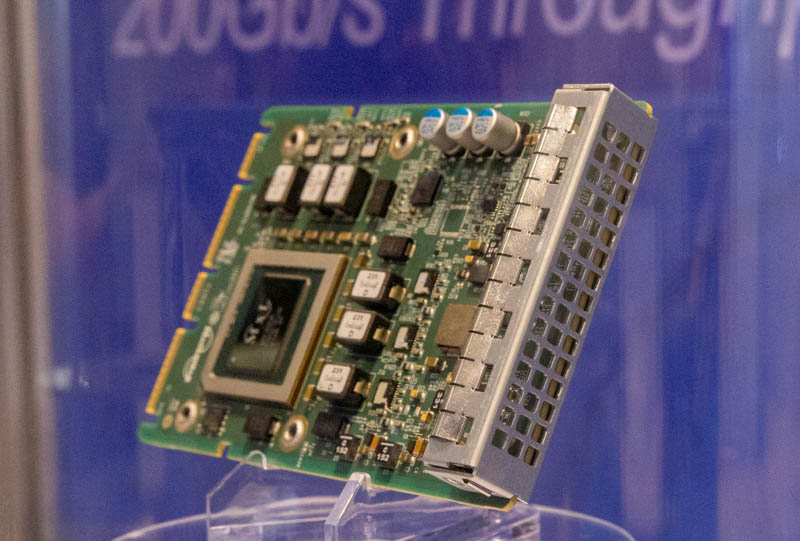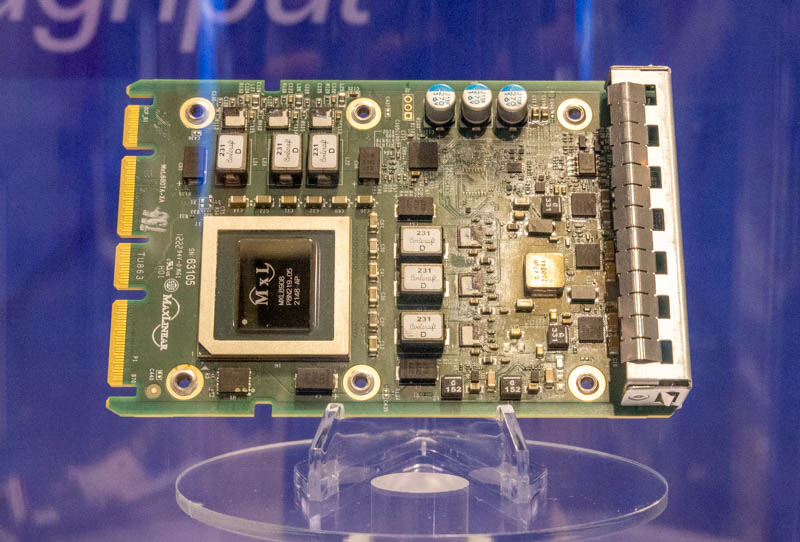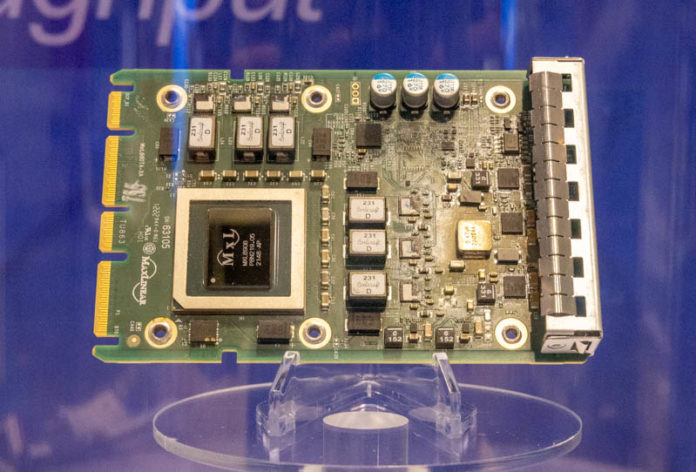At FMS 2022, MaxLinear, made one of the strangest claims: that it had a new DPU. The DPU or Data Processing Unit has generally become a network device that falls between a SmartNIC and an exotic FPGA solution. The MaxLinear Panther III was advertised as a “DPU” either as an assault on the intellectual prowess of conference attendees or the company’s investors. Since the term “DPU” has largely become an industry-accepted term, it was the equivalent of a manufacturer selling announcing it has a new “GPU” product even though it actually has a “SSD”.
MaxLinear Panther III is a Fake DPU at FMS 2022
This is the MaxLinear Panther III Fake DPU shown at FMS 2022. The basic concept is that it accelerates cryptographic and compression workloads. I asked the company point blank a number of questions to see if it had attributes aligned to a DPU, and their answers confirmed that it did not. It sounded like the company was calling this a DPU just to have folks come to say it was not. To be clear, the displays at the event clearly said that the product was a “DPU”, even though it is not.

For those in the industry that were unsure of where a device falls on the spectrum, we made a quick “What is a DPU?” guide and video:
At the time, we took what the industry players, including manufacturers and customers, were used to define DPUs, and distilled it into a set of criteria. In 2020, there was still some confusion about where a SmartNIC ended and where a DPU started on the spectrum.
The criteria have since been adopted by various vendors, analysts, and the press. STH has become so large with millions of monthly page views that we have become the source for much of the industry. Even large DPU vendors like NVIDIA have used some form of our definition for a DPU. We further introduced the 2021 STH NIC Continuum that has defined the difference between a basic NIC, offload NIC, SmartNIC, DPU, and exotic NIC.
These have been seen by hundreds of thousands of folks, if not more, and we have liberally given permission for others to use these frameworks in their own analyst presentations and elsewhere. The purpose was to clearly define the DPU so those looking for DPU solutions can understand what type of capabilities they will get. Likewise, we wanted to ensure DPU designations were used in the industry consistently so as not to mislead customers and investors.
An example was recently discussing the VMware vSphere 8 on DPU announcement, where an executive said “SmartNIC” on a pre-breifing. I asked the company to clarify if vSphere 8 would come to SmartNICs or DPUs, and the company confirmed they are not the same devices, and that only DPUs would be supported.
In those pieces that match others in the industry that have come out since we discussed some of the key characteristics that all DPUs, across vendors, share. Among them are:
- High-speed networking connectivity (usually multiple 100Gbps-200Gbps interfaces in this generation)
- High-speed packet processing with specific acceleration and often programmable logic (P4/ P4-like is common)
- A CPU core complex (often Arm or MIPS based in this generation)
- Memory controllers (commonly DDR4 but we also see HBM and DDR5 support)
- Accelerators (often for crypto or storage offload)
- PCIe Gen4 lanes (run as either root or endpoints)
- Security and management features (offering a hardware root of trust as an example)
- Runs its own OS separate from a host system (commonly Linux as we showed in our ZFS without a Server Using the NVIDIA BlueField-2 DPU piece, but the subject of VMware Project Monterey ESXi on Arm as another example)
At FMS 2022, I confirmed that several of these criteria were absent. For example, not only does the Panther III not include “high-speed” network connectivity, the MaxLinear products do not have networking ports at all. This was confirmed both by simple visual inspection as well as confirming with a booth representative. On the last item, as another example, at FMS 2022, I was told that the device does not run its own OS. It does have features like PCIe Gen4 and accelerators, but it has fewer than half of the mandatory features that we have seen by other DPU offerings in the industry.
- High-speed networking connectivity MaxLinear confirmed Panther III does not have
- High-speed packet processing with specific acceleration and often programmable logic MaxLinear confirmed Panther III does not have
- A CPU core complex MaxLinear confirmed Panther III does not have
- Memory controllers MaxLinear confirmed Panther III does not have controllers for OS memory (SRAM is present on most chips, but that is different from this meaning in DPUs)
- Accelerators Panther III has these
- PCIe Gen4 lanes Panther III has these
- Security and management features MaxLinear confirmed Panther III does not have, its security features are classified as “Accelerators” for these purposes
- Runs its own OS separate from a host system MaxLinear confirmed Panther III does not have
Of the eight common attributes all DPUs share, Panther III only has two. To give some sense, the degree to which MaxLinear misstated its product is not small. It was equivalent to a manufacturer calling its “SSD” a “GPU”. Both are PCIe devices. Both have PCIe interfaces (assuming this is NVMe.) Both have to process data. But they are clearly different devices that have become a term of art in the industry.

The Panther III is effectively an alternative to the Intel QuickAssist adapters, perhaps with higher level features than the older 40Gbps/ 100Gbps generations that are due to be replaced with the Intel Mount Evans IPU DPU and Sapphire Rapids. This is not on the same level as the Kalray K200-LP DPU that we evaluated via this framework and now cover under DPUs.
Final Words
This is one of the more bizarre moves. There are basically two narratives that I can envision. MaxLinear’s representatives clearly knew what a DPU was and decided to name a product that is in a completely different segment that does not have the minimum feature set of a DPU, as a DPU. The motivations we do not know. A customer would be able to clearly understand that the Panther III does not have high-speed networking based on photographs. Instead, we wonder if this misleading advertising and associated press release was designed to mislead potential investors into thinking that MaxLinear is competing in the hot DPU market.

If it is the latter, we hope the US SEC and securities firms will investigate and ensure that the company was not simply using the DPU name to mislead investors into thinking the company has entered the well-defined and hot DPU market.
There is a difference between “puffing” in marketing and making false claims. This is not in the realm of what the industry considers a DPU in 2022 when the claim was made. Investors without the technical savvy to understand the distinctions must be protected from claims like a company being in the DPU market even if the product is not in that market.





“DPU” is IMHO just like MMU, MPU, Co-Processor etc a term that w/o further explanation could apply to almost anything, a hard-disk-controller or even a security camera (that processes and stores image data). Always look at the specs and the PCB to verify!
@Jay Kastner: I’d agree that technically speaking it is a “Data Processing Unit” in that it processes storage data, but when an industry settles on a term like DPU to describe a certain type of hardware, in this case networking hardware, using the term to describe an unrelated device, even if the term is technically correct, is at best misleading.
I would have found this more interesting if it still included some specs, i.e. the throughput for compression etc., what their current clients are, etc. to know if it is at least a product that does well what it actually can do.
QAT is nice, but likely far from a dedicated offload Adapter like this.
I’m glad to see that you folks are becoming an Accepted Industry Zine – Mainstream no less. Good Job folks
You’d think they’re some underfunded startup with that. I’d not look at this product just for the dishonest advertising
Wow, calling and selling something as a thing that it’s not. That’s not suspect. Not suspect at all.
I’ve been following this whole “DPU” silliness for a little while now and while Patrick did a pretty decent job at trying to definitively quantify just what the hell a DPU really is, at the end of the day, any kind of device or chip that handles or “processes” data can be called a “data processing unit”, including a CPU, a GPU, any of the myriads of ASICs, micros and accelerators and interface controllers.
Jay Kastner has just said EXACTLY what I have been saying since all this started. It simply ain’t enough to merely label something a “DPU” without that all-important context that describes precisely WHAT kind(s) of “data” the thing is processing. Patrick’s breakdown of what this device here DOESN’T do shows his commitment to clearing up the confusion and is totally commendable here. And this stupid Panther III thing doesn’t even approach Patrick Kennedy’s OWN definition of what constitutes a “DPU”. How sad. It’s like “Let’s just further confound the buyers of our hardware and REALLY muddy up an already very vague technological term by misusing said term and selling our product as that even though WE know it isn’t, just so we make a killing AND create more discussion and discord over DPUs!”.
I’m starting to get like a certain AgentJayZ over on YouTube – I REALLY hate jargon, even more so when idiots and the like MISUSE and ABUSE it for their own selfish interests and monetary gain. It doesn’t help the end consumer at all and leads to more confusion and misunderstanding over complex technology. Kudos to Patrick Kennedy and the STH crew for doing their best to clear up and properly explain otherwise vague concepts and technical jargon so that we, the consumers, don’t get confused and hoodwinked.
That’s BS. US SEC should shut down this company for a stunt like this.
Basic problem is DPU as defined by STH does not contain the letter ‘N’.
N is for Network.
It is a bit like RoCE: there is no actual thing called “Converged Ethernet’. But Infiniband RDMA support was looking unbeatable so some fog was needed.
Which brings us to nVidia. nVidia didn’t have an X86 license and so it sought to turn X86 into a glorified carrier board for nV ARM+GPU. But it couldn’t come out and say that. Some fog and propaganda was needed. Some shine. DPU as defined by STH fit nV’s requirement perfectly.
Not that I think STH is bad, quite the opposite. But news reporters are best when they report the news, not when they try to make it. Should not have tried to canonicalize the term, IMO.
Interesting that nV is now going to make ARM servers for it’s GPU machines. Perhaps the punters see thru the fog a bit?
While I think the device doesn’t meet the commonly used definition of DPU in a NIC, I agree that it’s a weird thing to say that a DPU must be a NIC.
I’d be happy to see it not a DPU because it doesn’t meet the processing requirement of the DPU definition. There could be storage controllers built which could be described as a DPU (I don’t think there are?). But as this card lacks the memory, programmability and processing requirements, it doesn’t really seem to be a DPU.
It is a “storage accelerator”, as the marketing card says, and if they omitted the DPU acronym it wouldn’t be an issue. It’s a misplaced phrase and should be called out for sure.
The Linux Foundation OPI that they’ve linked is talking networking with DPU and IPU. I think they need NICs so this article is right.
And Ayes I don’t think STH is really a “news” or “reporter” site. STH is like the best analyst site out there compared to everything else. They’re the only site really doing things with DPUs and IPUs hands-on and so they’re like one of the most cross-platform DPU-IPU out there. They’re covering more providers than VMware, OPI, RedHat, or others so it’s as much STH’s domain as anyone else. I’d rather have these people define than just one company.
@Admin in NYC, disagree about news site. Reporting on anything one has to dig in otherwise one just prints press releases. That STH covers more than the usual suspects is part of what makes it good. If STH now thinks of itself as part of the industry then how am I to trust in it’s objectivity?
I’ve never seen an article like this one on STH before. A “fake” product. It is like a hit job. There are a tonne of companies promoting product under questionable labels in the computer racket. Don’t think it’s coincidence that Patrick wrote like about a bit of terminology that he thinks he created. He’s too invested in it.
This should have been published as a straight up product review. Let the product stand or fall on it’s own merits.
I think you’re splitting hairs here… The industry can’t even agree on a term (I’m looking at you Intel), even products that meet the list of requirements you’ve set forth to be a DPU, can’t even do anything overly useful, and I’m disappointed you didn’t bother to learn and report about Panther3.
In saying all that, I’ll make fun of MaxLinear next time I speak to them, about using the term DPU, because they should know better. Panther3 is a very interesting product though, you should follow up with them on details.
I don’t see any pics where they called it a DPU… just a box where they called it a “DPU Accelerator” which doesn’t seem to imply that it is a DPU, much as a “CPU Accelerator” does not imply it is a CPU.
STH should test it and after that do some real information for public. Is much more interesting have real data than read information around “names” and “no-names”. Maxlinear have tremendous IP, is not new. For me for exemple i’m very courious how they perform.